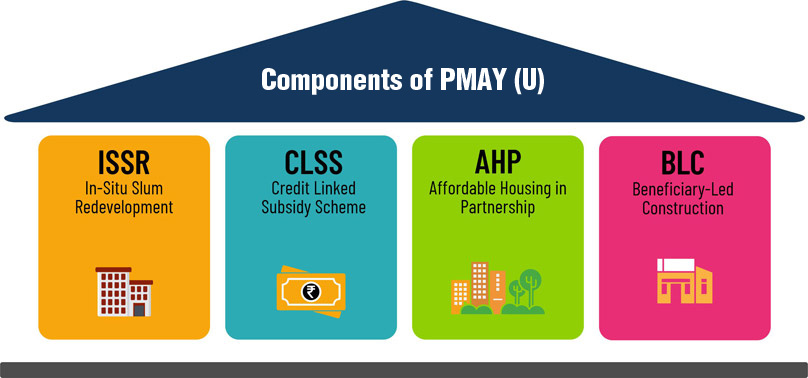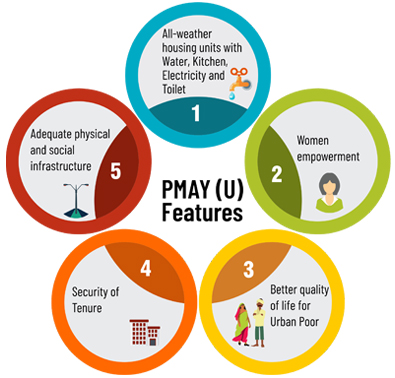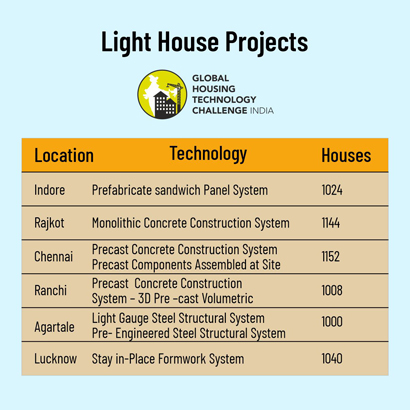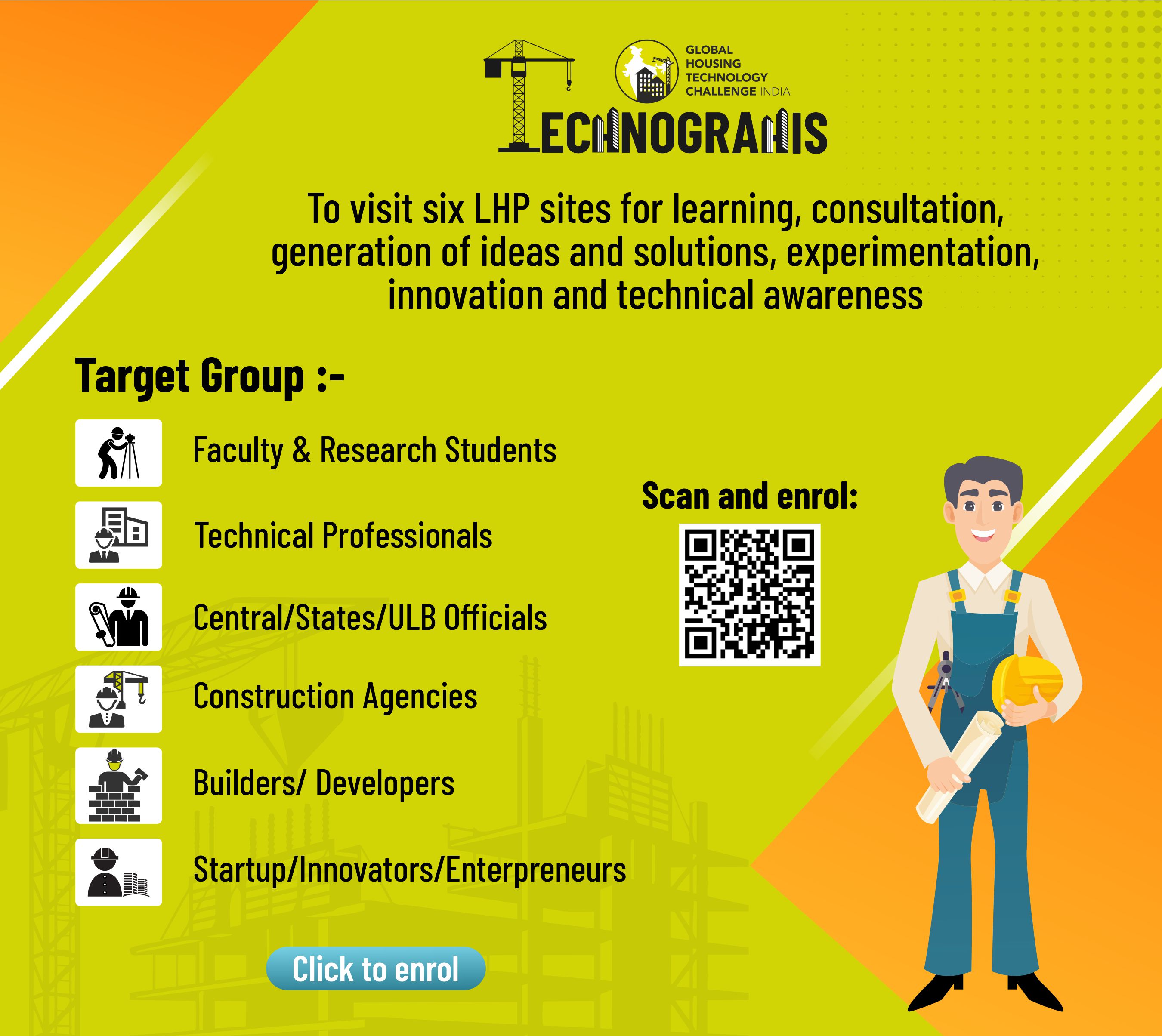In pursuance of Government’s vision of facilitating Housing for All, Ministry of Housing and Urban Affairs (MoHUA), Government of India is implementing Pradhan Mantri Awas Yojana- Urban (PMAY-U) – ‘Housing for All’ Mission since 25.06.2015. The original mission period was up to 31.03.2022 which has been extended till 31.12.2025 for completion of houses sanctioned up to 31.03.2022, without changing funding pattern and implementation methodology of the scheme. The validity of CLSS vertical was up to 31.03.2022. Under the Mission, Ministry has been providing Central assistance to States/ UTs for addressing the housing requirement of the slum dwellers and other people belonging to Economically Weaker Sections (EWS), Low Income Group (LIG) and Middle Income Group (MIG) categories in the urban areas through following four verticals:
1. Beneficiary-led Individual House Construction or Enhancement (BLC): Under this vertical, Central Assistance of ₹1.5 lakh is provided to individual eligible families belonging to EWS categories.
2. Affordable Housing in Partnership with public or private sector (AHP): Central Assistance of ₹1.5 lakh per EWS house is provided by Government of India in projects where at least 35% of the houses in the projects are for EWS category and a single project has at least 250 houses.
3. “In-situ” Slum Redevelopment (ISSR): Slum redevelopment grant of ₹1 lakh per house is admissible for all houses built for eligible slum dwellers under the vertical of In-situ Slum Redevelopment using land as Resource with participation of private developer.
4. Credit Linked Subsidy Scheme (CLSS): An interest subsidy of 6.5%, 4% and 3% on loan amount upto ₹6 lakh, ₹9 lakh and ₹12 lakh were admissible for the eligible beneficiaries belonging to Economically Weaker section (EWS)/Low Income Group (LIG), Middle Income Group (MIG)-I and Middle Income Group (MIG)-II respectively seeking housing loans from Banks, Housing Finance Companies and other such institutions. (CLSS for MIG was from 01.01.2017 to 31.03.2021)

The Mission is implemented as a Centrally Sponsored Scheme (CSS) except the CLSS vertical of PMAY-U which is implemented as a Central Sector Scheme.
A beneficiary family under the Mission comprises of husband, wife, unmarried sons and/or unmarried daughters. The beneficiary family should not own a pucca house (an all-weather dwelling unit) either in his/her name or in the name of any member of his/her family in any part of India. An adult earning member (irrespective of marital status) is treated as a separate household provided that:
Flexibility to States:
Ownership of House:
Coverage:

The dashboard has key information related to all the physical and financial progress of the Mission. It displays project wise data of all the houses under the Mission through easy-to-understand indicators. The Dashboard has information related to State/ULB-wise sanctioned houses, the current status & the timeline of the project- execution/ occupation stages, release of Central Assistance, status of utilization certificates, project timelines, graphical view of various stages of execution, etc. Centre, State/UT/City level Login IDs have been created for all stakeholders enabling them to have day-to-day status of each project in the respective State/UT. This helps each of the Implementing Agency to identify lags in performance of the project, and rectify the issues for better implementation.
A comprehensive and robust Management Information System (MIS) has been developed which helps all stakeholders to seamlessly manage information pertaining to physical and financial progress. The MIS allows submitting on-line demand survey with tracking facility and helps in housekeeping of various records through digitization of survey data, project information, beneficiary details, fund utilization, etc. MIS has also been integrated with CLAP for real-time monitoring mechanism, UMANG Mobile App, NITI Aayog Dashboard and DBT Bharat Portal for dissemination of information. The MIS has also been linked with the MIS of Pradhan Mantri Awas Yojana-Gramin (PMAY-G) for verifying duplication of beneficiaries.
The transfer of the Central Assistance and State/ULB share to the beneficiaries of the BLC vertical of the Mission is being done by States/UTs through DBT mode where the instalments are credited directly into the beneficiary’s bank account as per the geo-tagged stage of the construction with PFMS and GIS based MIS, etc.
MIS is equipped with five staged Geo-tagging features and integrated with BHUVAN Portal of National Remote Sensing Centre (NRSC) and BHARAT MAP of National Informatics Centre (NIC) for monitoring the progress of construction of houses under the BLC, ISSR and AHP verticals. Images of geo-tagged houses as moderated by States/ UTs are available in public domain.
CLAP has been designed, developed and implemented to provide a transparent and robust real-time web-based monitoring system for CLSS beneficiaries. The CLAP software works in tandem on a real-time basis with the UIDAI, CNAs, PLIs and PMAY-U MIS system for Aadhaar validation and de-duplication with other verticals of PMAY-U. The component of CLSS has been closed on 31.03.2022.
The application is being used under PMAY-U for dissemination of information and capturing the emotions of beneficiaries through photographs/video testimonials.
TSM was set up under PMAY-U with an objective to promote ‘Sustainable Technological Solutions for faster and cost effective construction of houses suiting to geo-climatic and hazard of the country. The Global Housing Technology Challenge- India was initiated in 2019 to identify and mainstream globally best available proven construction technologies that are sustainable, green and disaster-resilient to enable a paradigm shift in affordable housing sector. The major activities under GHTC-India are as follows:
As a part of GHTC- India, six LHPs, comprising of around 1000 houses each, have demonstrated construction of ready to live houses using alternate and innovative technologies. The LHPs have served as live laboratories for different aspects of transfer of technology to the field which includes planning, design, production of components, construction practices and testing. The objective is to mainstream the globally identified proven innovative technologies under GHTC-India in Indian context.

1. LHP Chennai: Inaugurated by Hon’ble Prime Minister on 26th May 2022, this project comprises of 1,152 houses built with Precast Concrete Construction System - precast components were assembled at site.
2. LHP Rajkot: Inaugurated by Hon’ble Prime Minister on 19th October 2022, this project comprises of 1,144 houses built using ‘Monolithic Concrete Construction using Tunnel Formwork’.
3. LHP Indore: Inaugurated by Hon’ble Prime Minister on 5th October 2023, this project comprises of 1,024 houses built using ‘Prefabricated Sandwich Panel System with Pre-engineered Steel Structural System’.
4. LHP Lucknow: Inaugurated by Hon’ble Prime Minister on 10th March 2024, this project comprises of 1,040 houses built using ‘Stay-in-place PVC Formwork with Pre-Engineered Steel Structural System’.
5. LHP Ranchi: Inaugurated by Hon’ble Prime Minister on 10th March 2024, this project comprises of 1,008 houses built using ‘Precast Concrete Construction System - 3D Volumetric’ technology.
6. LHP Agartala: Comprises of 1,000 houses, this project is in advance stage of construction using ‘Light Gauge Steel Framed System with Pre-engineered Steel Structural System’ technology.

An online enrolment module developed for all stakeholders to register themselves and visit LHP sites for learning the use of latest innovative technologies and adaption as per their local needs. ‘Technograhis’ include faculty & students of IITs/ NITs/ Engineering colleges/ Planning & Architecture colleges, Technical Professionals engaged in Private/ Public sectors, Central/ State/ ULB officials, Start-ups/ Innovators/ Entrepreneurs, and other concerned stakeholders. Around 40,000 Technograhis were enrolled across six LHPs till 31st March 2024.
DHPs comprise of around 40 dwelling units each to facilitate wide spread dissemination and adoption of new/alternate and sustainable building materials and technologies for the large-scale replication in different geo-climatic region of the country. These DHPs will have a common dining hall with kitchen, activity room, medical room, office, shops, etc. with special features like with Rain Water Harvesting and Solar street lights and are being used for social purposes.
Resilient Affordable Comfortable Housing through National Action (RACHNA) is a series of training programs on Innovative Construction Technologies & Thermal Comfort for Affordable Housing. A total of 75 region wise training and workshops were conducted under RACHNA. The focus of these trainings was on creating awareness among stakeholders on thermal comfort, its necessity in the affordable housing sector and ways to achieve it. More than 11,000 participants from Government/ Private sector, Academia, Masons/Artisans etc. participated in RACHNA Trainings.
New, Affordable, Validated, Research Innovation Technologies for Indian Housing (NAVARITIH) is a certificate course on Innovative Construction Technologies in collaboration with SPA Delhi and BMTPC. The course has familiarized the professionals with the latest materials and technologies being used worldwide for housing and has created awareness of the state-of-the-art materials/ technologies in terms of properties, specifications, performance, design and construction methodologies. A total of 1,123 participants in 17 batches have successfully completed the course till 31st March 2024.
To disseminate knowledge about the technology, construction process, sustainability, and mass-cum-fast construction to Technograhis. These webinars / training sessions are targeted for Faculty and students, technical professionals, start-ups/ entrepreneurs/ innovators who have enrolled themselves as “Technograhis”. A total of 12 webcasting sessions at LHPs sites have been conducted which was attended by more than 6,500 stakeholders virtually/physically.
In order to widen the horizon and to bring technology transition in the construction sector for sustainable development, various exhibition-cum-conferences were organized to bring together all global and indigenous innovative technologies, materials and process shortlisted under GHTC-India and showcase them to the relevant stakeholders on a common platform.
Inaugurated by Hon'ble Prime Minister, the Expo-Cum Conference was organized on 2 -3 March, 2019 in New Delhi. The expo brought together multiple stakeholders involved in innovative and alternative housing technologies, for exchange of knowledge and business opportunities through an exhibition, thematic sessions, panel discussions and master classes.
IHTM was organised on 5-7 October 2021 in Lucknow. The expo aimed to bring together innovative indigenous construction technology and material providers, innovators, entrepreneurs involved in low and mid-rise housing (upto four storeys) and end users at a common platform to achieve affordability, sustainability, disaster resilience while facilitating faster construction.
Inaugurated by Hon'ble Prime Minister, the conclave was organised on 19-21 October 2022 in Rajkot. The conclave and exhibition brought together Global and Domestic exhibitors who showcased the prototype models on new and innovative construction technologies/ materials. Technology providers from across the globe, domestic indigenous technologies, potential future technologies (start-ups) from the country exhibited their innovative construction technologies, materials and process.
The conference was organised on 25th August 2023 in New Delhi in association with CREDAI. It brought together real estate developers, subject matter experts, urban practitioners and stakeholders from various sectors of the construction industry for cross learning and sharing of ideas for adoption and mainstreaming of innovative construction technologies, materials and processes.
For providing decent rental housing at affordable rates to urban migrants/poor near their place of work, ARHCs was initiated as a sub-scheme under PMAY-U. This will provide ease of living to urban migrants/poor in Industrial Sector as well as in non-formal urban economy to get access to dignified affordable rental housing close to their workplace. ARHC scheme is being implemented through two models:
Model-1: Utilizing existing Government funded vacant houses to convert into ARHCs through Public Private Partnership or by Public Agencies.
Under Model-1, a total of 5,648 existing Government funded vacant houses (Chandigarh-2,195, Surat-393, Ahmedabad-1,376, Chittorgarh-480, Rajkot-698, Dehradun-70, Lalkuan-100, & Jammu-336) have been converted into ARHCs. Proposal for converting 7,413 vacant houses into ARHC units have been processed in the States of Gujarat, Himachal Pradesh, Haryana, Madhya Pradesh and Rajasthan.
Model-2: Construction, Operation and Maintenance of ARHCs by Public/Private Entities on their own available vacant land.
Under Model-2, proposals of 82,273 new ARHC units in 7 States approved. Work for construction of new ARHCs comprising of 44,114 units is in progress in various cities. At Sriperumbudur, Tamil Nadu, 3,969 units have been completed and are ready for inauguration.
In a bid to recognize the outstanding performance by States/UTs, ULBs and Beneficiaries, the PMAY(U) Awards have been instituted. The overarching purpose of the awards is to identify and felicitate the “Achievers” and encourage others to compete and attain the goal of ‘Housing for All’ in a sustained manner.
Hon’ble Prime Minister presented awards to Best Performing States for successful implementation of PMAY(U) and announced the awards for other categories through a video film. All the awards were presented through digital mode.
Hon’ble Prime Minister, during Indian Urban Housing Conclave-2022 in Rajkot, Gujarat, presented awards to Best Performing States for successful implementation of the mission. PMAY-U Awards 2021 were instituted in the form of a ‘150 Day Challenge’ for promoting a healthy competition amongst States/UTs to fast-track implementation mode to ensure completion and delivery of houses to the beneficiaries on time within the Mission period.
The third edition of PMAY-U Awards 2023 focuses on recognizing the proactive participation of beneficiaries from across the country and appreciating the commendable work done by States/UTs, ULBs, IAs under all four verticals of the Scheme i.e., BLC, CLSS, AHP and ISSR.
The results of PMAY-U Awards 2023 are yet to be announced.